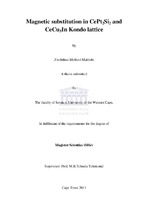| dc.description.abstract | In the past few decades, the studies of f-electron materials have revealed unusual physical properties such as Fermi-liquid, non-Fermi-liquid behaviour at low temperatures, heavy- Fermion behaviour, valence fluctuation, Kondo effect, superconducting and magnetic ordering. These materials include binary and ternary compounds and alloys with Cerium (Ce) or Ytterbium (Yb) based rare earth elements or Uranium (U) based actinide element. In these systems the localized magnetic moments formed by Ce, Yb or U ions transform the electronic properties of these compounds leading to quasiparticles with masses in excess to 1000 times the bare electron mass. These materials are known as heavy-fermion materials. Two well known heavy – Fermion compounds with Ce based rare earth elements of interest in this thesis are CePt₂Si₂ and CeCu₅In. The effect of substituting Ce with moment bearing Tb or Dy in these two compounds, are reported through measurements of electrical resistivity, magnetic susceptibility and magnetization. The three alloy systems (Ce₁₋ₓREₓ)Pt₂Si₂ (RE = Tb, Dy) and (Ce₁₋ₓTbᵪ)Cu₅In under investigation in the present thesis, was synthesized and characterized by x-ray diffraction. The alloy systems (Ce₁₋ₓREₓ)Pt₂Si₂ (RE = Tb, Dy, 0≤ ᵡ ≤1) formed a single phase in the P4/nmm tetragonal CaBe₂Ge₂ – type structure across the whole series while the (Ce₁₋ₓTbᵪ)Cu₅In alloy system formed a single phase in the Pnma orthorhombic CeCu₆ – type crystal structure up to 40% Ce substitution. The physical properties of these systems is reported and discussed through the measurements of electrical resistivity, magnetic susceptibility and magnetization. The variables of this study are: the doping concentration of Tb or Dy, the applied magnetic field and the sample temperature. Electrical resistivity studies for all the systems revealed coherence effect at Ce – rich alloys (0≤ ᵡ ≤0.2) and single-ion Kondo scattering with further increased RE concentration ( ᵡ ≥ 0.3). The magnetic property studies indicate antiferromagnetic ordering only for the (Ce₁₋ₓREₓ)Pt₂Si₂ alloy system in the concentration range 0.7≤ ᵡ ≤ 1. The present thesis is comprised of six chapters, which are arranged as follows: The first chapter deals with the theoretical background of the physical properties of Ce based intermetallics compounds and alloys. Experimental techniques constitutes chapter II and explains the techniques used in this study. The theoretical overview of the two parent compounds of interest in this thesis (CePt₂Si₂ and CeCu₅In) is presented in chapter III. The fourth and the fifth chapters of this study deals with results and discussion. The thesis is completed with a conclusion in chapter six. | en_US |

